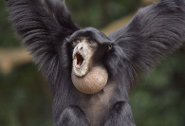 The Siamang (Hylobates syndactylus) is a gibbon quite similar in looks to a monkey. However, the Siamangs has white cheeks and no tail. The Siamang differs from all other primates because it is a syndactylus, which means that it has two toes on each foot that are webbed. This webbing is between their second and third toes.
The Siamang (Hylobates syndactylus) is a gibbon quite similar in looks to a monkey. However, the Siamangs has white cheeks and no tail. The Siamang differs from all other primates because it is a syndactylus, which means that it has two toes on each foot that are webbed. This webbing is between their second and third toes.They have shaggy black fur and are the largest and darkest species of gibbon. These gibbons have a hairless pouch on their throat that expands when they are vocalizing. This pouch makes them much louder, able to be heard over three kilometers through the jungle. They have large forearms and are very skillful at using their legs and feet to carry things around. These creatures are quick and agile, able to gracefully travel through the treetops.
Siamangs are a bit larger than other gibbons. They are 74 to 89 cm (29 to 35 inches) tall and about 10 - 14 kg (23 - 30 pounds). They live in rain forests in Malaysia, Thailand and the Indonesian island of Sumatra. They don't touch the ground often, staying instead on the tops of trees. They find on leaves, fruits, flowers, insects and bird eggs. They especially like figs.
Siamangs tend not to do well in captivity, they are much too territorial.
The Siamang are considered to be endangered. Due to hunting and a loss of their habitat, the Siamang has decreased greatly in number. Fires or destruction of the rainforests have cleared out much of their home. They are also popular with illegal pet traders. These poachers kill the mothers, who are very protective of their babies, and take the infants. Many of these infants unfortunately die during transport.
Picture of the Siamang by suneko, licensed under the Creative Commons Attribution 2.0 Generic license.

Custom Search